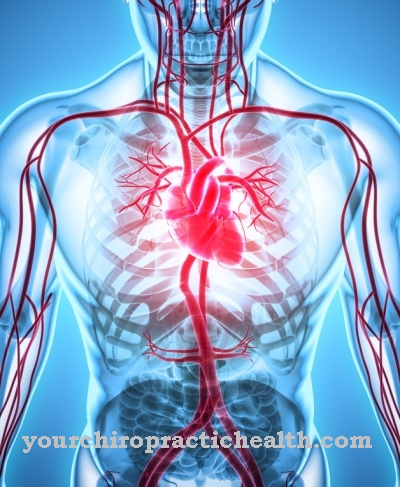The Melanin production, which occurs through specialized basal cells in the epidermis, the melanocytes, primarily serves to protect the skin and the cell nuclei of the skin cells from the harmful UV component in sunlight. The melanocytes are able to synthesize the skin pigment melanin from the non-essential proteinogenic amino acid L-tyrosine. Secondly, the individual composition of the melanins influences hair and eye color.
What is Melanin Production?

The biocatalytic synthesis of melanin by melanocytes is called melanin production. The melanocytes are located directly on the basement membrane, the lowest layer of the upper skin (epidermis) and supply the keratinocytes with the pigment melanin, whereby one melanocyte supplies several keratinocytes at the same time via cell extensions (dendrites).
The keratinocytes gradually migrate from the basement membrane to the top layer of the skin over the course of their 28-day life cycle, where they are exfoliated as tiny horny platelets.
The melanin production of melanocytes is mainly controlled by incident UVB light. In humans, melanin consists of a mixed form of brownish to blackish eumelanins, which are synthesized from the non-essential proteinogenic amino acid L-tyrosine and levodopa, and from yellowish to reddish sulfur-containing phaeomelanins. The melanocytes synthesize and "store" the melanin formed in small vesicles, the melanosomes. The transfer of the color pigments to the keratinocytes takes place with the help of the melanosomes. The composition of the melanins produced, i.e. the mixing ratio between eumelanins and pheomelanins, is largely genetically determined.
Function & task
The main task of melanin production in the epidermis is to protect the top layer of skin, the epidermis or epidermis, from damage caused by excessive UV radiation. The main task and function is taken over by the melanocytes; they not only synthesize the color pigments, but also transfer them to the keratinocytes, where the melanin protects the cell nucleus and also protects the other organelles from the harmful UV component of sunlight.
The keratinocytes enriched with melanin make the skin appear darker and browner. It takes several weeks until the skin is completely “tanned” because the melanocytes can only ever supply the lowest layers of the keratinocytes with melanin and the lowest keratinocytes only “arrive” after 28 days on the skin surface.
It is very likely that the UV protection in red-haired and light-blonde people with a particularly light skin type, whose melanins contain a high proportion of pheomelanins, have less UV protection than dark-skinned people with dark brown or black hair.
The immediate benefit of melanin production for humans lies in the fact that the melanin provides initial photo protection immediately after strong UV radiation by converting the excited molecules into heat. The short-term photo protection prevents free radicals and so-called reactive oxygen species from developing.
Another quickly effective protection is created by the immediate pigmentation after UV radiation. In this case, the melanocytes have already supplied the skin cells with precursors of melanin, which is converted into melanin by UV radiation, i.e. it does not have to be newly synthesized. However, this protection is only slightly effective and reversible. Skin tanned in this way loses its color again after a few days if there is no more UV radiation. Longer-term and stronger protection results from consistent pigmentation of the epidermis when it is exposed to UV radiation almost daily.
Illnesses & ailments
The most common diseases and complaints in connection with melanin production are an over- or under-functioning of the melanocytes, which can be triggered by a too large or too low number of melanocytes or by a malfunction in the synthesis of melanin. Over and underfunction are usually noticeable in the form of pigmentation disorders on the skin, which occur due to inherited genetic defects or were acquired through external influences.
A very rare and complete failure of melanin production is what is known as albinism, which manifests itself in extremely white skin, which is highly sensitive to UV rays, as well as white hair and a pale gray eye color.
A well-known pigment disorder that occurs predominantly in the extremities, face and genital area is vitiligo, which usually begins in childhood and gradually progresses over the course of life. The peculiarity is noticeable through irregular white spots on the skin. It is probably an autoimmune disease in the course of which the melanocytes in certain skin regions are destroyed.
Well-known hyperpigmentation are liver spots, freckles and age spots. All three types of pigment disorder are usually harmless and only have cosmetic effects. The occurrence of locally limited hyperpigmentation depends on many factors such as genetic predisposition and UV exposure. Age spots that appear from the age of about 40 years can also be promoted as a side effect of certain medications, excessive alcohol consumption and cigarette smoking. The pigment disorders known as moles or birthmarks are based on congenital disorders or disorders acquired through stress on the skin.
Malignant melanomas are less harmless; they are malignant tumors that develop from degenerate melanocytes and tend to spread to the lymphatic system earlier. Melanomas can develop from altered moles or birthmarks, but can also develop in completely inconspicuous areas of the skin. Another type of tumor is the basalioma, which can form on the basal cells of the epidermis. Basaliomas are less prone to spreading, making them easier to treat and therefore classified as semi-malignant tumors.




.jpg)








.jpg)

.jpg)
.jpg)










